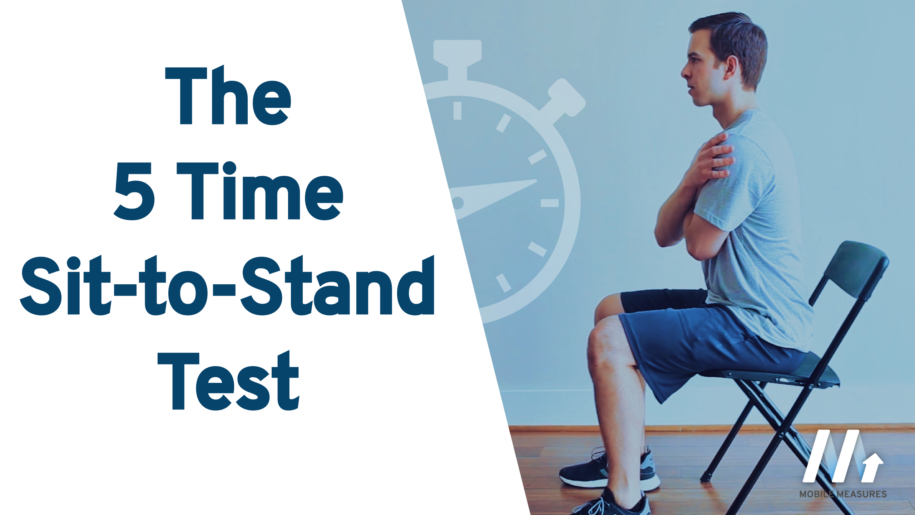Share on facebook
Share on twitter
Share on linkedin
Share on email
Understanding the abilities of patients to complete everyday tasks can indicate functional limitations and quality of life. The Five Times Sit to Stand Test (5xSTS) can be a valuable tool for therapists assessing functional independence, is simple to administer, and requires minimal equipment.
What is the Five Times Sit-to-Stand Test?
The sit to stand movement is a fundamental activity of daily life and can provide valuable insight into a patient’s health and functional status. The 5xSTS measures the amount of time it takes for a patient to sit and stand five times in succession with arms folded across their chest.
The 5xSTS has been studied extensively in persons aged 20 to 90+ with various neurologic and orthopedic diagnoses that may impact their mobility.
The test can be used to identify patients at risk of falling (Buatois et al, 2010), hospitalization (Cesari et al, 2009), functional decline (Deshpande et al, 2013), caregiver requirement (Shimada et al, 2013), frailty (Abizanda et al, 2012), and more.
Equipment needed
All that is needed to do the 5XSST is a standard height chair (43 cm) with a backrest and the ability to time and record the results of the test.
Instructions
- The patient begins seated with their back against a chair and arms folded across their chest.
- The therapist should stand beside the patient and appropriately guard to ensure safety.
- Instructions for patient: “When I say ‘Go’, stand up and sit down as quickly as you can 5 times in a row. Stand fully upright each time and try not to touch the backrest when you sit between reps.”
- Demonstrate the test.
- Have the patient perform 1 practice trial, followed by 1-3 timed trials.
- When the patient is ready, say “Go” and start the timer.
- Stop the timer when the patient’s buttocks touches the seat following the 5th stand.
Scoring the test
- Record the time from command “Go” until the patient’s buttocks touches the seat following the 5th stand.
- Perform 1-3 timed trials.
- Final score is the average of the timed trials.
Interpretation of the Five Times Sit-to-Stand Test
Accurate measurement and recording of the 5xSTS is crucial in determining effectiveness of interventions. Furthermore, it is important that the normative data and cut-off scores used to interpret your patient’s results matches their demographics. This is because what is considered “normal” for one patient may be “abnormal” for another due to physiological differences in age, gender, and diagnoses.
Normative data for the 5xSTS test (Bohannon et al, 2010; Lusardi et al, 2003):
- 20-29 yrs ⇒ 6.0±1.4 sec
- 30-39 yrs ⇒ 6.1±1.4 sec
- 40-49 yrs ⇒ 7.6±1.8 sec
- 50-59 yrs ⇒ 7.7±2.6 sec
- 60-69 yrs ⇒ 8.4±0.0 sec (male), 12.7±1.8 sec (female)
- 70-79 yrs ⇒ 11.6±3.4 sec (male), 13.0±4.8 sec (female)
- 80-89 yrs ⇒ 16.7±4.5 sec (male), 17.2±5.5 sec (female)
- 90+ yrs ⇒ 19.5±2.3 sec (male), 22.9±9.6 sec (female)
Cut-off scores offer a number of insights into patient risk and functional ability:
Patients with a score of greater than or equal to 17 seconds have been found to have a 30% greater risk of hospitalization (Cesari et al, 2009).
Older adults are at risk of recurrent falls with scores greater than 15 seconds (Buatois, et al, 2010).
Increased fall risk in patients with Parkinson’s Disease was found for scores greater than 16 seconds (Duncan et al, 2011). Similarly, those with vestibular disorders had an increased fall risk with scores over 15 seconds (Buatois, et al, 2008).
A minimal change in the score will offer a noticeable improvement in function (Duncan et al, 2011; Meretta et al, 2006). Patients who are able to decrease their score by as little as 2.5 seconds will see significant improvement.
Long term goals should be to improve the patient’s score to within normal for their age bracket and to reduce the risk of falling, hospitalization, and functional decline. Minimally, the goal should be for a patient’s score to be below 17 seconds.
References
- Buatois S, Perret-Guillaume C, Gueguen R, et. el. A simple clinical scale to stratify risk of recurrent and older falls in community-dwelling adults aged 65 years. Phys Ther. 2010;90(4):550-560.
- Cesari M, Kritchevsky SB, Newman AB, et al. Added value of physical performance measures in predicting adverse health-related events: results from the health, aging, and body composition study. Journal of the American Geriatrics Society. 2009;57(2):251-259.
- Deshpande N, Metter EJ, Guralnik J, et al. Predicting 3-year incident mobility disability in middle-aged and older adults using physical performance tests. Arch Phys Med Rehabil. 2013;94(5):994-997.
- Shimada H, Suzuki T, Suzukawa M, et al. Performance-based assessments and demand for personal care in older Japanese people: a cross-sectional study. BMJ open. 2013;3(4).
- Abizanda P, Romero L, Sanchez-Jurado PM, Atienzar-Nunez P, et al. Association between functional assessment instruments and frailty in older adults: the FRADEA study. J Frailty Aging. 2012;1(4):162-8.
- Bohannon RW, Bubela DJ, Magasi SR, et al. Sit to stand test: performance and determinants across the age-span. Isokinet Exerc Sci. 2010;18:235–240.
- Lusardi M. Functional Performance in Community Living Older Adults. Journal of Geriatric Physical Therapy. 2003. 26(3):14-22.
- Duncan RP, Leddy AL, et al. Five times sit-to-stand test performance in parkinson’s disease. Arch Phys Med Rehabil. 2011;92(9):1431-1436.
- Buatois S, Manckoundia P, Gueguen R, et al. Five times sit to stand test is a predictor of recurrent falls in healthy community-living subjects aged 65 and older. J Am Geriatr Soc. 2008;56(8):1575-1577.
- Meretta B, Whitney S, Marchetti G, et al. The five times sit to stand test: Responsiveness to change and concurrent validity in adults undergoing vestibular rehabilitation. Journal of Vestibular Research. 2006;16:233‐243.
